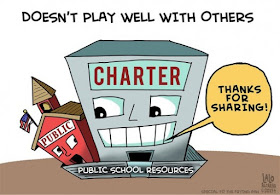Union-commissioned report says charter schools are bleeding money from traditional ones
A teachers union-funded report on charter schools concludes that these largely nonunion campuses are costing traditional schools in the Los Angeles Unified School District millions of dollars in tax money.
The report, which is certain to be viewed with skepticism by charter supporters, focused on direct and indirect costs related to enrollment, oversight, services to disabled students and other activities on which the district spends money.
L.A. Unified has the most charters — 221 — and the highest number of charter students — more than 100,000 — of any school system in the nation. Charter students make up about 16% of the district's total enrollment.
The union gave The Times the study in advance of its scheduled presentation at Tuesday's Board of Education meeting, with the stipulation that the report not be distributed to outside parties.
The study calculates that services to charters encroach on tax money the district intended to use for traditional schools, adding up to at least $18.1 million a year and growing.
The biggest financial problem for the district, however, is that money follows students and a huge number of students have enrolled in charters instead of traditional district schools. With more education tax dollars going directly to charters, the result is a decline of more than $500 million a year — about 7% — in the district's core budget, the researchers say.
The effects of this drop are difficult to quantify because fewer students in traditional schools also means a reduced need for teachers and other personnel.
But even with reduced staffing, the district faces a net loss of about $4,957 per student, the study says. That amount accounts for fixed costs, such as maintaining buildings.
Whatever the exact amount, the district has less money to spend with the flexibility its leaders would prefer or to offset legacy costs that include aging school buildings and retiree health benefits.
“The findings in the report paint a picture of a system that prioritizes the growth opportunities for charter school operators,” according to a separate policy brief co-written by the union.
Charter supporters take a different view, seeing the district as the fundamental problem and charters as an important solution.
“Like all businesses, the district has to compete for its customers,” said Eric Hanushek, a senior fellow at the Hoover Institution at Stanford University.
“The growth of charters is putting pressure on the district. The district can't do what it did in the past and come out ahead,” added Hanushek, who hadn't seen the report. “They can try to compete for the students or sell off the buildings. But the point is: Charters look attractive to parents, which means that the district is not attractive.”
Prompted in part by concern about the district's judgment in how it spends money, a group of philanthropists and foundations has bet big on charters in Los Angeles, subsidizing their growth over the last two decades. Last year, local philanthropist Eli Broad spearheaded a proposal to more than double the number of charters over the next eight years, hoping to reel in half of district students.
About six months ago, a group formed to develop Broad's vision for new, high-quality schools.
Meanwhile, both the district and employee unions have been trying to develop counter-strategies. From the district, the push is to increase enrollment, to compete with charters more aggressively and possibly to limit their growth. Until now, the union has been most visible at the bully pulpit, speaking at gatherings and leading demonstrations.
The new report is from Florida company MGT of America. It builds on the work of an earlier, independent district advisory panel, which concluded that charter growth is one of several factors threatening the solvency of L.A. Unified.
This latest analysis was reviewed by pro-labor Washington group In the Public Interest, which prepared the separate policy brief with the union.
“Unmitigated charter school growth limits educational opportunities for the more than 542,000 students who continue to attend schools run by the district, and … further Union-commissioned report says charter schools are bleeding money from traditional ones - LA Times:



